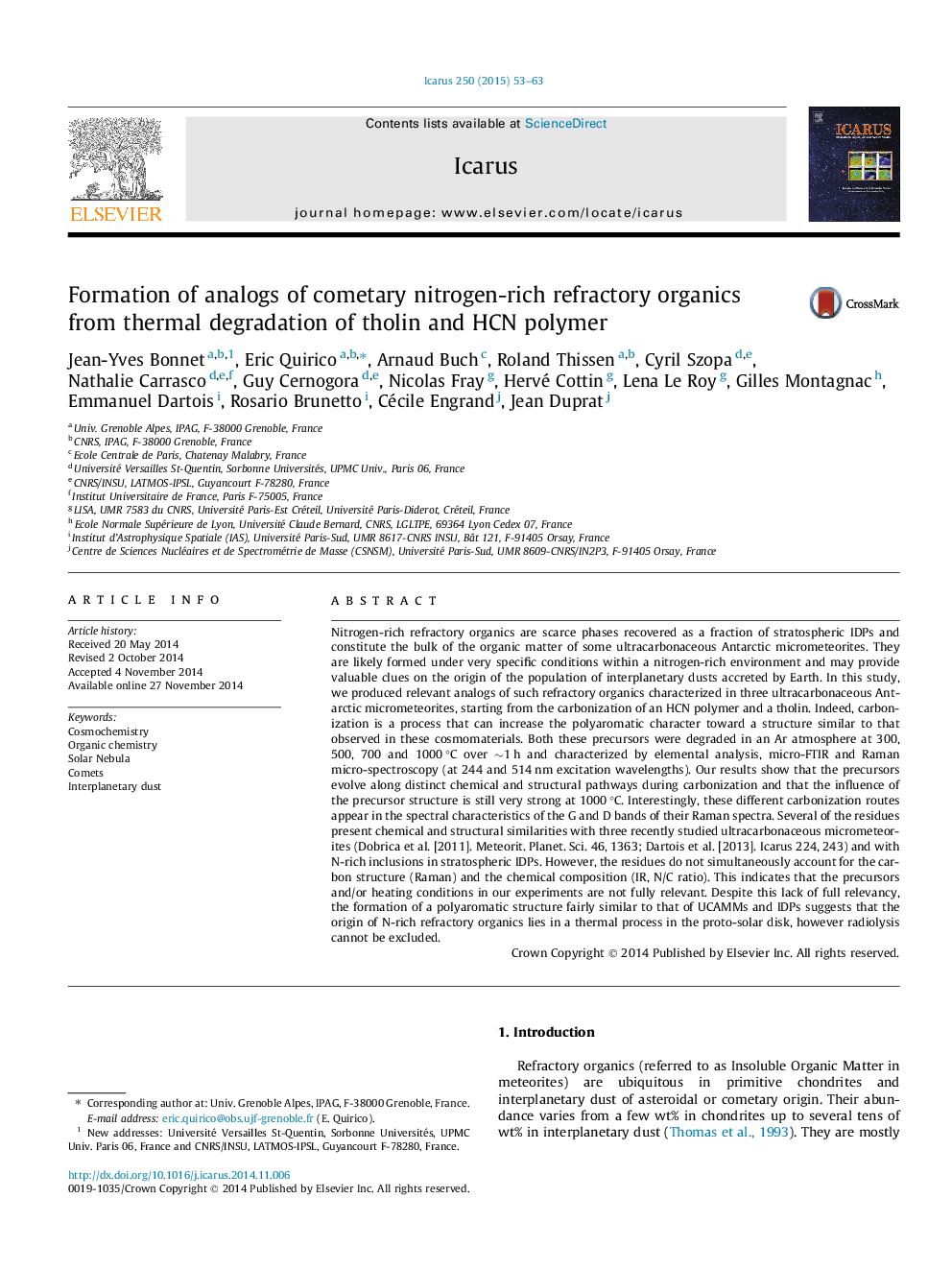| کد مقاله | کد نشریه | سال انتشار | مقاله انگلیسی | نسخه تمام متن |
|---|---|---|---|---|
| 8136694 | 1523540 | 2015 | 11 صفحه PDF | دانلود رایگان |
عنوان انگلیسی مقاله ISI
Formation of analogs of cometary nitrogen-rich refractory organics from thermal degradation of tholin and HCN polymer
دانلود مقاله + سفارش ترجمه
دانلود مقاله ISI انگلیسی
رایگان برای ایرانیان
کلمات کلیدی
موضوعات مرتبط
مهندسی و علوم پایه
علوم زمین و سیارات
علوم فضا و نجوم
پیش نمایش صفحه اول مقاله

چکیده انگلیسی
Nitrogen-rich refractory organics are scarce phases recovered as a fraction of stratospheric IDPs and constitute the bulk of the organic matter of some ultracarbonaceous Antarctic micrometeorites. They are likely formed under very specific conditions within a nitrogen-rich environment and may provide valuable clues on the origin of the population of interplanetary dusts accreted by Earth. In this study, we produced relevant analogs of such refractory organics characterized in three ultracarbonaceous Antarctic micrometeorites, starting from the carbonization of an HCN polymer and a tholin. Indeed, carbonization is a process that can increase the polyaromatic character toward a structure similar to that observed in these cosmomaterials. Both these precursors were degraded in an Ar atmosphere at 300, 500, 700 and 1000 °C over â¼1 h and characterized by elemental analysis, micro-FTIR and Raman micro-spectroscopy (at 244 and 514 nm excitation wavelengths). Our results show that the precursors evolve along distinct chemical and structural pathways during carbonization and that the influence of the precursor structure is still very strong at 1000 °C. Interestingly, these different carbonization routes appear in the spectral characteristics of the G and D bands of their Raman spectra. Several of the residues present chemical and structural similarities with three recently studied ultracarbonaceous micrometeorites (Dobrica et al. [2011]. Meteorit. Planet. Sci. 46, 1363; Dartois et al. [2013]. Icarus 224, 243) and with N-rich inclusions in stratospheric IDPs. However, the residues do not simultaneously account for the carbon structure (Raman) and the chemical composition (IR, N/C ratio). This indicates that the precursors and/or heating conditions in our experiments are not fully relevant. Despite this lack of full relevancy, the formation of a polyaromatic structure fairly similar to that of UCAMMs and IDPs suggests that the origin of N-rich refractory organics lies in a thermal process in the proto-solar disk, however radiolysis cannot be excluded.
ناشر
Database: Elsevier - ScienceDirect (ساینس دایرکت)
Journal: Icarus - Volume 250, April 2015, Pages 53-63
Journal: Icarus - Volume 250, April 2015, Pages 53-63
نویسندگان
Jean-Yves Bonnet, Eric Quirico, Arnaud Buch, Roland Thissen, Cyril Szopa, Nathalie Carrasco, Guy Cernogora, Nicolas Fray, Hervé Cottin, Lena Le Roy, Gilles Montagnac, Emmanuel Dartois, Rosario Brunetto, Cécile Engrand, Jean Duprat,